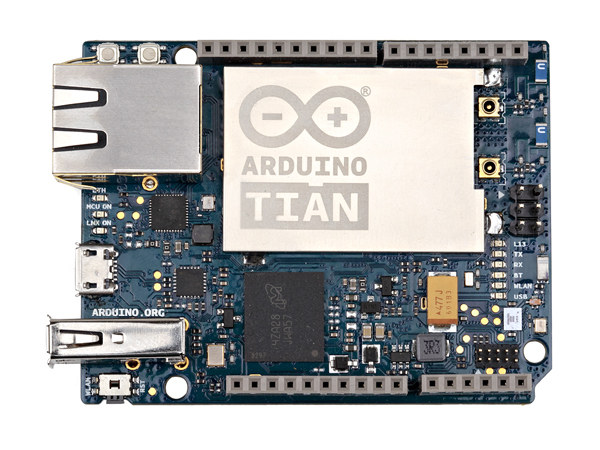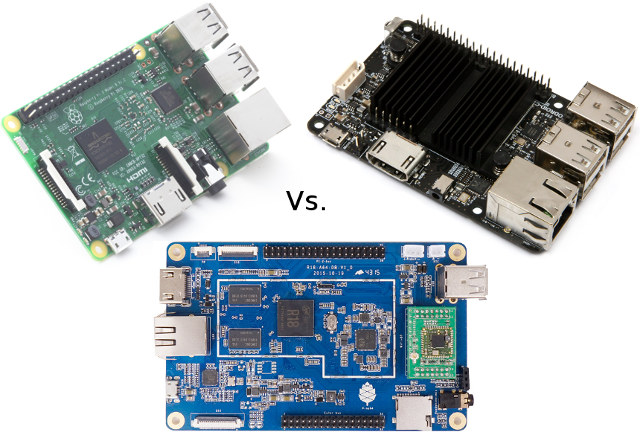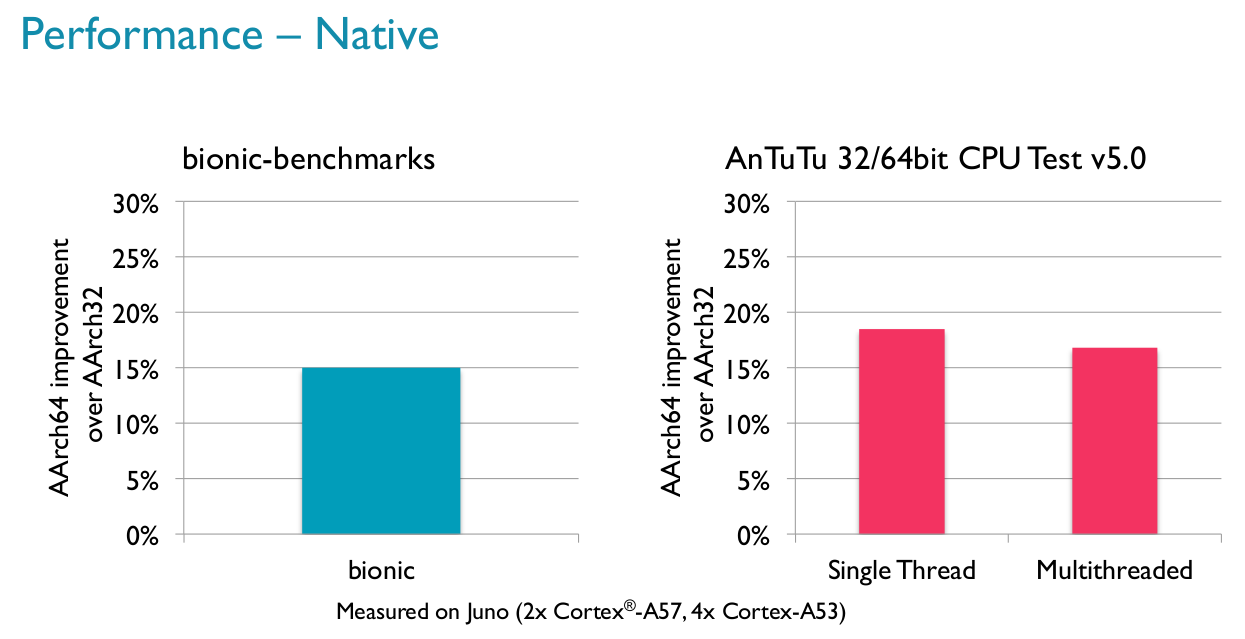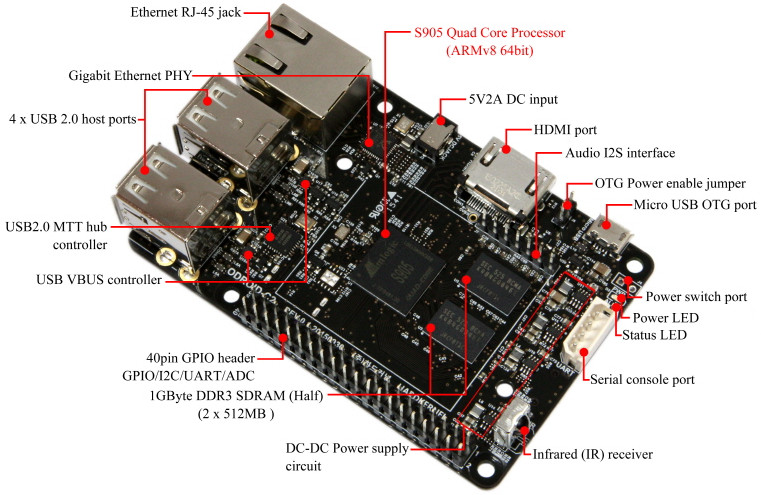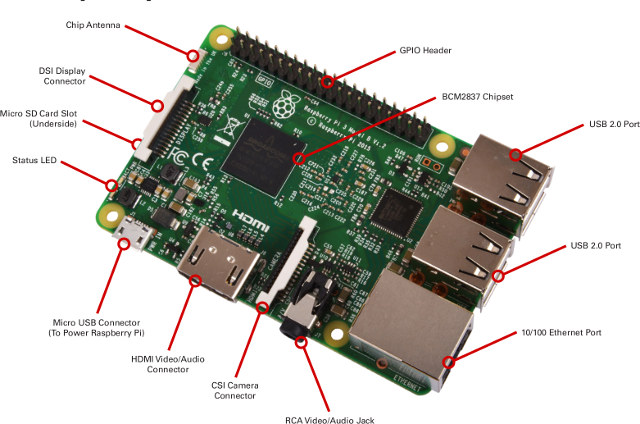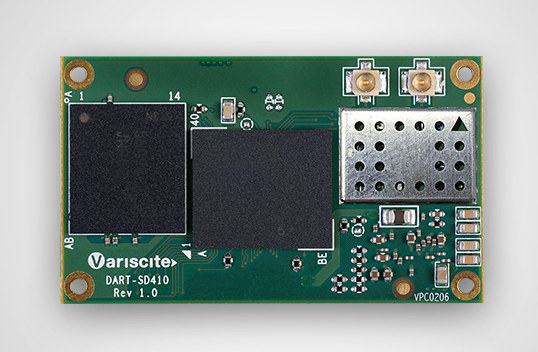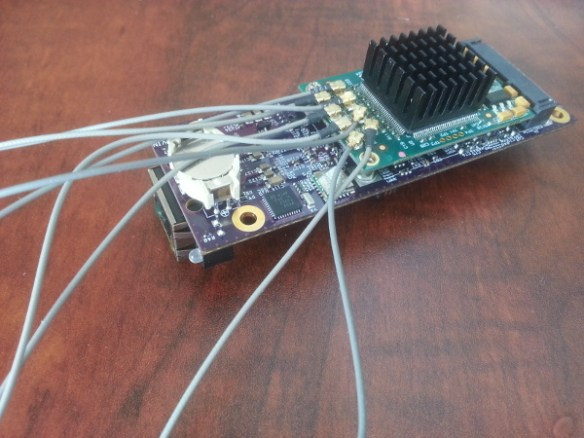Arduino Tian is an update of Arduino Yun board, mainly replacing Atmel ATMega32u4 8-bit MCU and Atheros AR9331 WiSoC with more recent Atmel SAMD21 32-bit Cortex M0 MCU and Atheros AR9342 WiSoC with support for dual band 802.11 b/g/n WiFi, as well as CSR8510 Bluetooth 4.0 SoC. Arduino Tian specifications: MCU part MCU – Atmel SAMD21G18 ARM Cortex-M0 MCU @ 48 MHz with 256KB flash and 32KB SRAM Digital I/O Pins – 20x GPIOs with 12x PWM and UART Analog Input Pins – 6x 12-bit ADC channels Analog Output Pins – 1x 10-bit DAC DC Current per I/0 – 7mA Operating Voltage – 3.3V “Linux” SoC part SoC – Atheros AR9342 MIPS74Kc processor @ 535 MHz System Memory 64MB DDR2 Storage – 16 MB Flash for firmware, 4 GB eMMC Flash for data Connectivity – 10/100M Ethernet, dual band 802.11n 2×2 2.4/5 GHz WiFi, Bluetooth 4.0 + EDR (CSR8510) USB […]
Raspberry Pi 3, ODROID-C2 and Pine A64+ Development Boards Comparison
Raspberry Pi 3 and hardkernel ODROID-C2 launched the same day, and together with Pine A64/A64+, are the only ultra low cost (<$40) 64-bit ARM development boards available or soon-to-be available, so I’ve decided to make a comparison of the three boards the same way I did with ~$10 boards with a Raspberry Pi Zero, C.H.I.P, and Orange Pi One comparison. I’ve used features of Pine A64+ instead of Pine A64 since features and price are closer to the other two boards. Text highlighted in green means a board is clearly better than the other two for a given features, while a red highlight means it’s the weakest of the three. Raspberry Pi 3 ODROID-C2 Pine A64 Plus Processor Broadcom BCM2837 quad core Cortex A53 processor @ 1.2 GHz(4x ~2760 DMIPS) Amlogic S905 quad core Cortex A53 processor @ 2.0 GHz(4x ~4600 DMIPS) Allwinner A64 quad core Cortex A53 processor @ […]
GNU Complexity Command Line Tool Measures Complexity of C Code
GNU complexity is a command line tool that computes a complexity measure of C source code, similar to pmccabe, but with a different method of calculating results with short functions scoring lower than pmccabe and highly nested functionality can score considerably higher. It can be useful to locate suspicious areas in unfamiliar code, get an idea of the efforts required to either understand the code or test it, or self-assess your own code. Bruce Korb, the maintainer, has just released version 1.5 with some bug fixes, so I’ve given it a quick try. We’ll need to get the code, build and install it first:
|
1 2 3 4 5 6 |
wget ftp://ftp.gnu.org/gnu/complexity/complexity-1.5.tar.gz tar xvf complexity-1.5.tar.gz cd complexity-1.5 ./configure make -j8 sudo make install |
The user’s manual provides some insights and an example, which I’ve used against a directory in Linux source code:
|
1 2 3 4 5 6 7 8 9 10 11 12 13 14 15 16 17 18 19 20 21 22 23 24 25 26 27 28 29 30 31 32 33 34 35 36 37 38 39 40 41 42 43 44 45 46 47 48 49 50 51 52 53 54 55 56 57 58 59 60 61 62 63 64 65 66 67 68 69 70 71 72 73 74 75 76 77 78 79 80 81 82 83 84 85 86 |
cd ~/edev/linux/arch/arm64/kernel complexity --histogram --score --thresh=3 `ls *.c` procedure fpsimd_pm_init in fpsimd.c ended before final close bracket procedure fpsimd_hotplug_init in fpsimd.c ended before final close bracket Complexity Scores Score | ln-ct | nc-lns| file-name(line): proc-name 3 28 17 perf_callchain.c(111): perf_callchain_user 3 20 18 insn.c(337): aarch64_insn_decode_immediate 3 21 19 io.c(27): __memcpy_fromio 3 21 19 io.c(56): __memcpy_toio 3 30 19 cpufeature.c(860): verify_local_cpu_capabilities 3 21 20 module.c(74): reloc_data 3 24 20 setup.c(199): request_standard_resources 3 27 20 alternative.c(89): __apply_alternatives 3 29 20 cpu_ops.c(53): cpu_read_enable_method 3 29 24 insn.c(362): aarch64_insn_encode_immediate 3 31 24 ptrace.c(76): ptrace_hbptriggered 3 54 24 kgdb.c(159): kgdb_arch_handle_exception 3 28 25 armv8_deprecated.c(145): update_insn_emulation_mode 3 32 25 debug-monitors.c(334): aarch32_break_handler 3 35 26 smp.c(413): acpi_map_gic_cpu_interface 3 42 26 process.c(249): copy_thread 3 58 27 perf_event.c(572): armv8pmu_handle_irq 3 32 28 hw_breakpoint.c(544): toggle_bp_registers 3 34 28 insn.c(1019): aarch64_insn_gen_data3 3 34 29 insn.c(519): aarch64_insn_gen_comp_branch_imm 3 56 29 setup.c(121): smp_build_mpidr_hash 3 35 30 insn.c(397): aarch64_insn_encode_register 3 42 31 signal.c(167): setup_sigframe 3 37 33 hw_breakpoint.c(349): arch_bp_generic_fields 3 49 34 setup.c(232): relocate_initrd 3 41 35 insn.c(708): aarch64_insn_gen_add_sub_imm 3 63 38 setup.c(292): setup_arch 3 109 57 cpufeature.c(469): update_cpu_features 4 46 26 smp.c(477): of_parse_and_init_cpus 4 38 31 traps.c(335): call_undef_hook 4 36 32 insn.c(924): aarch64_insn_gen_data1 4 49 33 armv8_deprecated.c(464): cp15barrier_handler 4 71 34 stacktrace.c(41): unwind_frame 4 42 35 ptrace.c(437): hw_break_set 4 42 37 insn.c(968): aarch64_insn_gen_data2 4 49 37 smp.c(708): handle_IPI 4 58 37 hw_breakpoint.c(231): hw_breakpoint_control 4 47 40 insn.c(757): aarch64_insn_gen_bitfield 4 54 44 ptrace.c(376): hw_break_get 4 60 44 armv8_deprecated.c(378): swp_handler 5 28 27 hw_breakpoint.c(198): hw_breakpoint_slot_setup 5 45 35 ptrace.c(672): compat_gpr_get 5 50 36 hw_breakpoint.c(764): reinstall_suspended_bps 5 59 37 hw_breakpoint.c(476): arch_validate_hwbkpt_settings 5 48 42 insn.c(811): aarch64_insn_gen_movewide 5 49 42 insn.c(868): aarch64_insn_gen_add_sub_shifted_reg 5 60 44 psci.c(36): cpu_psci_cpu_init_idle 5 49 46 insn.c(277): aarch64_get_imm_shift_mask 5 95 89 asm-offsets.c(34): main 6 34 32 cpufeature.c(792): __raw_read_system_reg 6 67 37 signal.c(332): do_signal 6 43 39 topology.c(50): parse_core 6 54 41 ptrace.c(724): compat_gpr_set 6 74 44 traps.c(147): dump_backtrace 6 55 49 insn.c(646): aarch64_insn_gen_load_store_pair 6 76 49 hw_breakpoint.c(393): arch_build_bp_info 6 71 52 hw_breakpoint.c(584): breakpoint_handler 6 61 54 insn.c(1062): aarch64_insn_gen_logical_shifted_reg 6 73 59 ptrace.c(1120): compat_arch_ptrace 8 50 30 cpuinfo.c(102): c_show 8 64 50 topology.c(97): parse_cluster 8 97 65 hw_breakpoint.c(660): watchpoint_handler 9 44 32 traps.c(59): dump_mem 11 71 55 signal32.c(129): copy_siginfo_to_user32 31 198 172 module.c(184): apply_relocate_add Complexity Histogram Score-Range Lin-Ct 0-9 2206 ************************************************************ 10-19 55 * 20-29 0 30-39 172 ***** Scored procedure ct: 65 Non-comment line ct: 2433 Average line score: 7 25%-ile score: 3 (75% in higher score procs) 50%-ile score: 5 (half in higher score procs) 75%-ile score: 6 (25% in higher score procs) Highest score: 31 (apply_relocate_add() in module.c) |
The resulting table shows six information per line: the computed score, the number of lines between the opening and closing curly braces (ln-ct), the number […]
64-bit ARM (Aarch64) Instructions Boost Performance by 15 to 30% Compared to 32-bit ARM (Aarch32) Instructions
Yesterday was quite an eventful day with the launch of two low cost 64-bit ARM development boards, namely Raspberry Pi 3 and ODROID-C2, and as usual there were some pretty interesting discussions related to the launch of the boards in the comments section. One of the subject that came is that while Raspberry Pi 3 board is using a 64-bit processor, the operating systems are still compiled with 32-bit instructions (Aarch32) and even optimized for ARMv6, and they intend to keep it that way according to Eben Upton interview: Eben readily admits that not all the capabilities of the new parts are going to be used at launch, however. “Although it is a 64‑bit core, we’re using it as just a faster 32-bit core,” he reveals about the Pi 3’s central processing unit. “I can imagine there’d be some real benefits [to 64-bit code]. The downside is that you do […]
ODROID-C2 64-Bit ARM Development Board is Now Available for Purchase for $40
ODROID-C2 is a quad core 64-bit ARM development board based on Amlogic S905 processor with 2GB RAM that was planned to launch in early March, but maybe unsurprisingly, Hardkernel decided to launch their latest board, the very same day as Raspberry Pi 3 launch. We already knew the specifications, but it’s always useful to mind ourselves of the details: SoC – Amlogic S905 quad core cortex-A53 processor @ 2.0 GHz with 3+2 cores Mali-450 GPU System Memory – 2GB DDR3 SDRAM Storage – eMMC module socket with 8, 16, 32, or 64GB module by Toshiba or Sandisk + micro SD slot supporting UHS-1 SD cards. Video Output – HDMI 2.0 up to 4K @ 60 Hz Connectivity – Gigabit Ethernet (Realtek RTL8211F) USB – 4x USB 2.0 host ports + micro USB OTG port Expansion Header 40-pin header with GPIO, I2C, UART, and ADC ; All I/Os are 3.3V, except […]
Raspberry Pi 3 Board is Powered by Broadcom BCM2837 Cortex A53 Processor, Sells for $35
Raspberry Pi 3 board was first found on the FCC website, and thanks to various other leaks we had a pretty good idea of the board specifications including a Broadcom 64-bit ARM processor coupled with 1GB RAM, WiFi and Bluetooth, as well as basically the same features and ports as Raspberry Pi 2 Model B. But with the fourth anniversary of the Raspberry Pi Model 1 board, Raspberry Pi 3 has now officially been launched, and you can now purchase the board for $35. Raspberry Pi 3 specifications: SoC – Broadcom BCM2837 64bit ARMv8 quad core Cortex A53 processor @ 1.2GHz with dual core VideoCore IV GPU @ 400 MHz supporting OpenGL ES 2.0, hardware-accelerated OpenVG, and 1080p30 H.264 high-profile decode. Capable of 1Gpixel/s, 1.5Gtexel/s or 24GFLOPs with texture filtering and DMA infrastructure System Memory – 1GB LPDDR2 Storage – micro SD slot Video & Audio Output – HDMI 1.4 […]
Variscite DART-SD410 Snapdragon 410 SoM Comes with WiFi 802.11 b/g/n, Bluetooth 4.1 & GPS
Qualcomm Snapdragon 410 is the 64-bit ARM processor used in DragonBoard 410c 96Boards platform, but it’s also found in several phones, some single board computers such as Inforce 6309, and we’ve also seen it in system-on-modules includes Graperain G8916 and Intrinsyc Open-Q 410. Variscite has developed their DART-SD410 system-on-module based on the processor with up to 2GB RAM, up to 16GB storage, and on-board 802.11b/g/n WiFi and Bluetooth 4.1. DART-SD410 module specifications: SoC – Qualcomm Snapdragon 410 quad core Cortex A53 processor @ 1.2GHz with Adreno 306 GPU @ 400 MHz System Memory – 1 to 2GB LPDDR3 @ 533 MHz Storage – 8 to 16 GB eMMC 4.5 flash Connectivity – WiFi 802.11 b/g/n + Bluetooth 4.1 LE (WCN3620), GPS (WGR7640), and two u.FL antenna connectors Audio – PM8916 PMIC/Audio codec I/Os available via 2x 90-pin board-to-board connectors: Display 4-lane DSI up to 720p60/1080p30, 24-bit On-carrier DSI to HDMI […]
AVC8000nano mini PCIe Frame Grabber Captures up to 8 D1 Videos
There are plenty of solutions to stream or capture multiple video streams from cameras, but example for security purpose, but usually the equipment is relatively large and heavy. Advanced Micro Peripherals AVC8000nano mini PCIe capture card miniaturizes all that thanks to its form factor, and its 8 u.FL connectors used to capture eight D1 videos at full frame rate. AVC8000nano features: Video Inputs 8x Live NTSC/PAL video inputs with 8x 10-bit ADC and anti-aliasing filters 8x D1 size capture at full frame rate Formats – NTSC-M, NTSC-Japan, NTSC (4.43), RS-170, PAL-B,G,N, PAL-D, PAL-H, PAL-I, PAL-M, PAL-CN, PAL-60 SECAM Adjustments – Contrast, saturation, hue (or chroma phase), and brightness. Software adjustable Sharpness, Gamma and noise suppression Video Capture Formats – RGB555, RGB565, YCbCr 4:2:2, YCbCr 4:1:1 Windows support with Drivers and DirectShow/DirectDraw Linux with drivers and Video4Linux Form factor – Full height mini PCI Express Temperature Range – Commercial: 0°C to […]


